The Impact of Earlywood and Latewood on the Compressive Stress of Thermally Modified Douglas Fir
Abstract
:1. Introduction
2. Materials and Methods
2.1. Preparation of Specimens
2.2. Compression Test and Digital Image Correlation
2.3. Microstructural Observation
2.4. Data Analysis
3. Results
3.1. Physical and Mechanical Properties
3.2. Microstructural Changes
3.3. Strain Distribution in ELW Specimens
4. Discussion
5. Conclusions
Author Contributions
Funding
Data Availability Statement
Acknowledgments
Conflicts of Interest
References
- Walker, J.C. Primary Wood Processing: Principles and Practice; Springer: Dordrecht, The Netherlands, 2006. [Google Scholar]
- Mvolo, C.S.; Koubaa, A.; Beaulieu, J.; Cloutier, A.; Defo, M.; Yemele, M.-C. Phenotypic correlations among growth and selected wood properties in white spruce (Picea glauca (Moench) Voss). Forests 2019, 10, 589. [Google Scholar] [CrossRef] [Green Version]
- Hu, W.; Zhang, J. Effect of growth rings on acoustic emission characteristic signals of southern yellow pine wood cracked in mode I. Constr. Build. Mater. 2022, 329, 127092. [Google Scholar] [CrossRef]
- Kosiachevskyi, D.; Hachem, E.L.; Abahri, K.; Bennacer, R.; Chaouche, M. Biomaterials heterogeneous displacement, strain and swelling under hydric sorption/desorption: 2D image correlation on spruce wood. Constr. Build. Mater. 2021, 286, 122997. [Google Scholar] [CrossRef]
- Xu, L.; Zhang, H.; Xu, F.; Zheng, C.; Wu, J. Study on the constructions of special wettability surface of earlywood and latewood. J. For. Eng. 2022, 7, 35–42. [Google Scholar]
- Boutelje, J. The relationship of structure to transverse anisotropy in wood with reference to shrinkage and elasticity. Holzforschung 1962, 16, 33–46. [Google Scholar] [CrossRef]
- Li, W.; Zhang, Z.; Zhou, G.; Kibleur, P.; Mei, C.; Shi, J.; Van Acker, J.; Van den Bulcke, J. The effect of structural changes on the compressive strength of LVL. Wood Sci. Technol. 2020, 54, 1253–1267. [Google Scholar] [CrossRef]
- Nziengui, C.F.P.; Turesson, J.; Pitti, R.M.; Ekevad, M. Experimental Assessment of the Annual Growth Ring’s Impact onthe Mechanical Behavior of Temperate and Tropical Species. BioResources 2020, 9, 105–119. [Google Scholar]
- Lanvermann, C.; Hass, P.; Wittel, F.K.; Niemz, P. Mechanical properties of Norway spruce: Intra-ring variation and generic behavior of earlywood and latewood until failure. BioResources 2014, 9, 105–119. [Google Scholar] [CrossRef] [Green Version]
- Jeong, G.Y. Relationship between anatomical and mechanical properties of loblolly pine (Pinus taeda). For. Prod. J. 2013, 63, 47–53. [Google Scholar] [CrossRef]
- Buksnowitz, C.; Evans, R.; Müller, U.; Teischinger, A. Indented rings (hazel growth) of Norway spruce reduce anisotropy of mechanical properties. Wood Sci. Technol. 2012, 46, 1239–1246. [Google Scholar] [CrossRef]
- Czajkowski, Ł.; Olek, W.; Weres, J. Effects of heat treatment on thermal properties of European beech wood. Eur. J. Wood Wood Prod. 2020, 78, 425–431. [Google Scholar] [CrossRef] [Green Version]
- Widmann, R.; Fernandez-Cabo, J.L.; Steiger, R. Mechanical properties of thermally modified beech timber for structural purposes. Eur. J. Wood Wood Prod. 2012, 70, 775–784. [Google Scholar] [CrossRef] [Green Version]
- Wang, X.; Chen, X.; Xie, X.; Wu, Y.; Zhao, L.; Li, Y.; Wang, S. Effects of thermal modification on the physical, chemical and micromechanical properties of Masson pine wood (Pinus massoniana Lamb.). Holzforschung 2018, 72, 1063–1070. [Google Scholar] [CrossRef] [Green Version]
- Welzbacher, C.R.; Wehsener, J.; Rapp, A.O.; Haller, P. Thermo-mechanical densification combined with thermal modification of Norway spruce (Picea abies Karst) in industrial scale—Dimensional stability and durability aspects. Eur. J. Wood Wood Prod. 2008, 66, 39–49. [Google Scholar] [CrossRef]
- Stamzl-Tschegg, S.; Beikircher, W.; Loidl, D. Comparison of mechanical properties of thermally modified wood at growth ring and cell wall level by means of instrumented indentation tests. Holzforschung 2009, 63, 443–448. [Google Scholar] [CrossRef]
- Cabezas-Romero, J.L.; Salvo-Sepúlveda, L.; Contreras-Moraga, H.; Perez-Pena, N.; Sepúlveda-Villarroel, V.; Wentzel, M.; Ananías, R.A. Microstructure of thermally modified Radiata Pine wood. BioResources 2021, 16, 1523. [Google Scholar] [CrossRef]
- Hamada, J.; Pétrissans, A.; Mothe, F.; Ruelle, J.; Pétrissans, M.; Gérardin, P. Variations in the natural density of European oak wood affect thermal degradation during thermal modification. Ann. For. Sci. 2016, 73, 277–286. [Google Scholar] [CrossRef] [Green Version]
- Hamada, J.; Pétrissans, A.; Mothe, F.; Ruelle, J.; Pétrissans, M.; Gérardin, P. Intraspecific variation of European oak wood thermal stability according to radial position. Wood Sci. Technol. 2017, 51, 785–794. [Google Scholar] [CrossRef]
- Chen, Z.; Gabbitas, B.; Hunt, D. A thermal imaging technique for studying crack development in wood under torsional loading. J. Mater. Sci. 2005, 40, 1929–1935. [Google Scholar] [CrossRef]
- Li, W.; Zhang, Z.; Wang, X.; Mei, C.; Van Acker, J.; Van den Bulcke, J. Understanding the effect of growth ring orientation on the compressive strength perpendicular to the grain of thermally treated wood. Wood Sci. Technol. 2021, 55, 1439–1456. [Google Scholar] [CrossRef]
- Li, W.; Zhang, Z.; Yang, K.; Mei, C.; Van den Bulcke, J.; Van Acker, J. Understanding the effect of combined thermal treatment and phenol–formaldehyde resin impregnation on the compressive stress of wood. Wood Sci. Technol. 2022, 56, 1071–1086. [Google Scholar] [CrossRef]
- Kutnar, A.; Sandberg, D.; Haller, P. Compressed and moulded wood from processing to products. Holzforschung 2015, 69, 885–897. [Google Scholar] [CrossRef]
- Tu, D.; Chen, C.; Zhou, Q.; Ou, R.; Wang, X. Research progress of thermo-mechanical compression techniques for wood products. J. For. Eng. 2021, 6, 13–20. [Google Scholar]
- Dubey, M.K.; Pang, S.; Chauhan, S.; Walker, J. Dimensional stability, fungal resistance and mechanical properties of radiata pine after combined thermo-mechanical compression and oil heat-treatment. Holzforschung 2016, 70, 793–800. [Google Scholar] [CrossRef]
- Tabarsa, T.; Chui, Y.H. Stress-strain response of wood under radial compression. Part I. Test method and influences of cellular properties. Wood Fiber Sci. 2000, 32, 144–152. [Google Scholar]
- Boonstra, M.J.; Van Acker, J.; Tjeerdsma, B.F.; Kegel, E.V. Strength properties of thermally modified softwoods and its relation to polymeric structural wood constituents. Ann. For. Sci. 2007, 64, 679–690. [Google Scholar] [CrossRef] [Green Version]
- Li, M.; Zhang, S.; Wang, Y.; Ren, H. Effect of Microstructures on the Shear Strength of Larix kaempferi. Forests 2021, 12, 830. [Google Scholar] [CrossRef]
- Mańkowski, P.; Laskowska, A. Compressive strength parallel to grain of earlywood and latewood of yellow pine. Maderas. Cienc. Y Tecnol. 2021, 23. [Google Scholar] [CrossRef]
- Xiang, E.; Feng, S.; Yang, S.; Huang, R. Sandwich compression of wood: Effect of superheated steam treatment on sandwich compression fixation and its mechanisms. Wood Sci. Technol. 2020, 54, 1529–1549. [Google Scholar] [CrossRef]
- Keckes, J.; Burgert, I.; Frühmann, K.; Müller, M.; Kölln, K.; Hamilton, M.; Burghammer, M.; Roth, S.V.; Stanzl-Tschegg, S.; Fratzl, P. Cell-wall recovery after irreversible deformation of wood. Nat. Mater. 2003, 2, 810–813. [Google Scholar] [CrossRef]
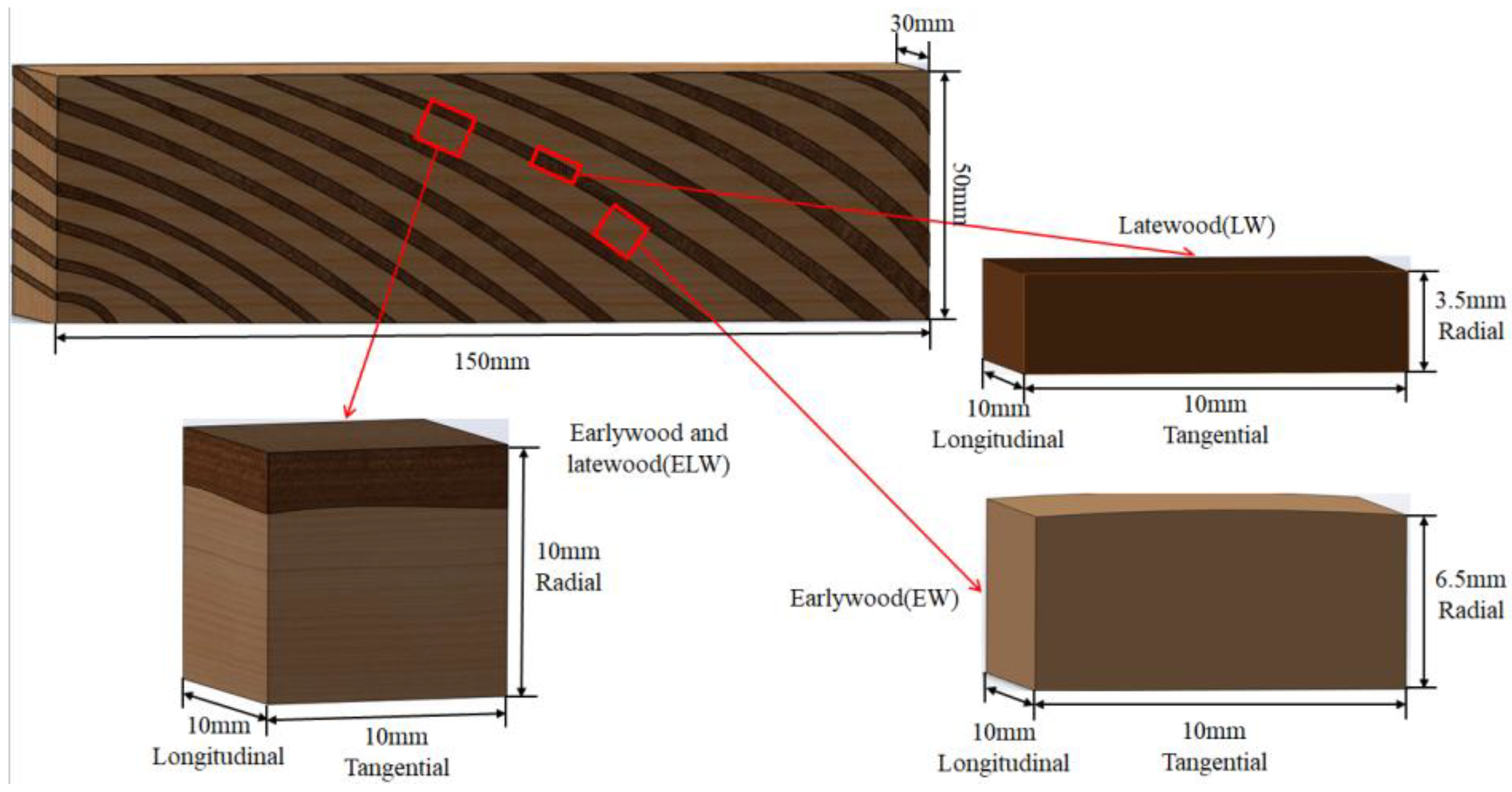
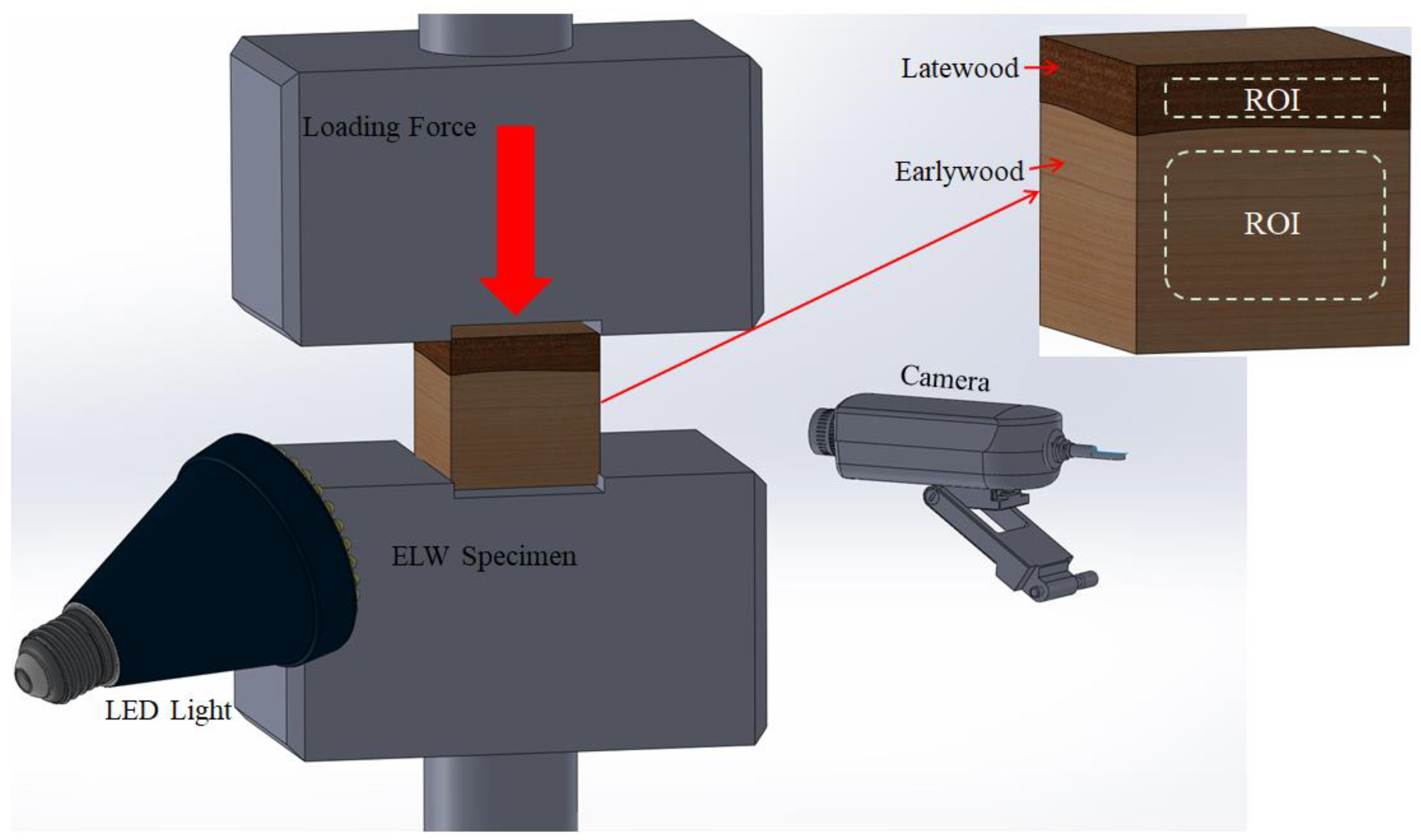
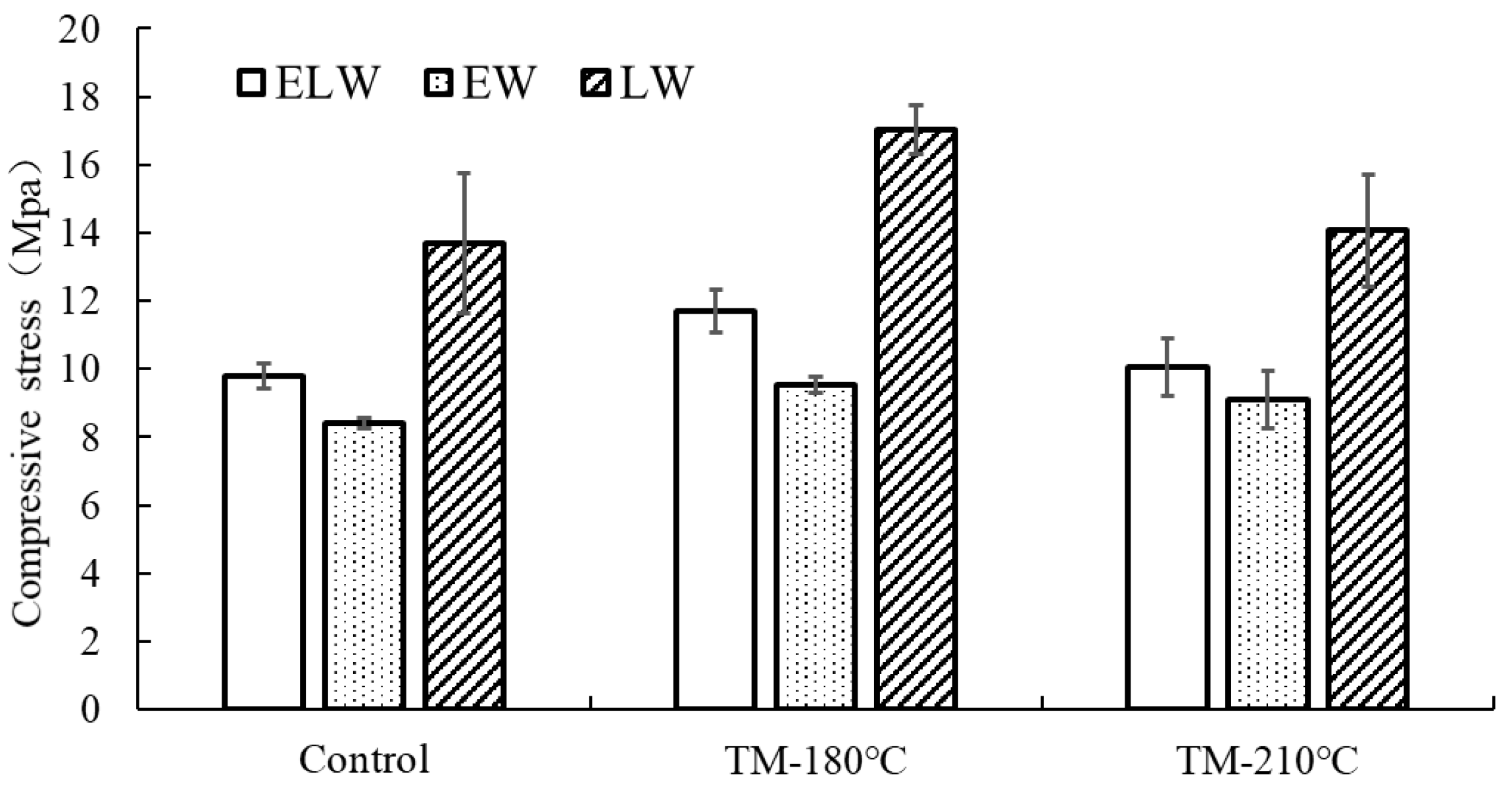

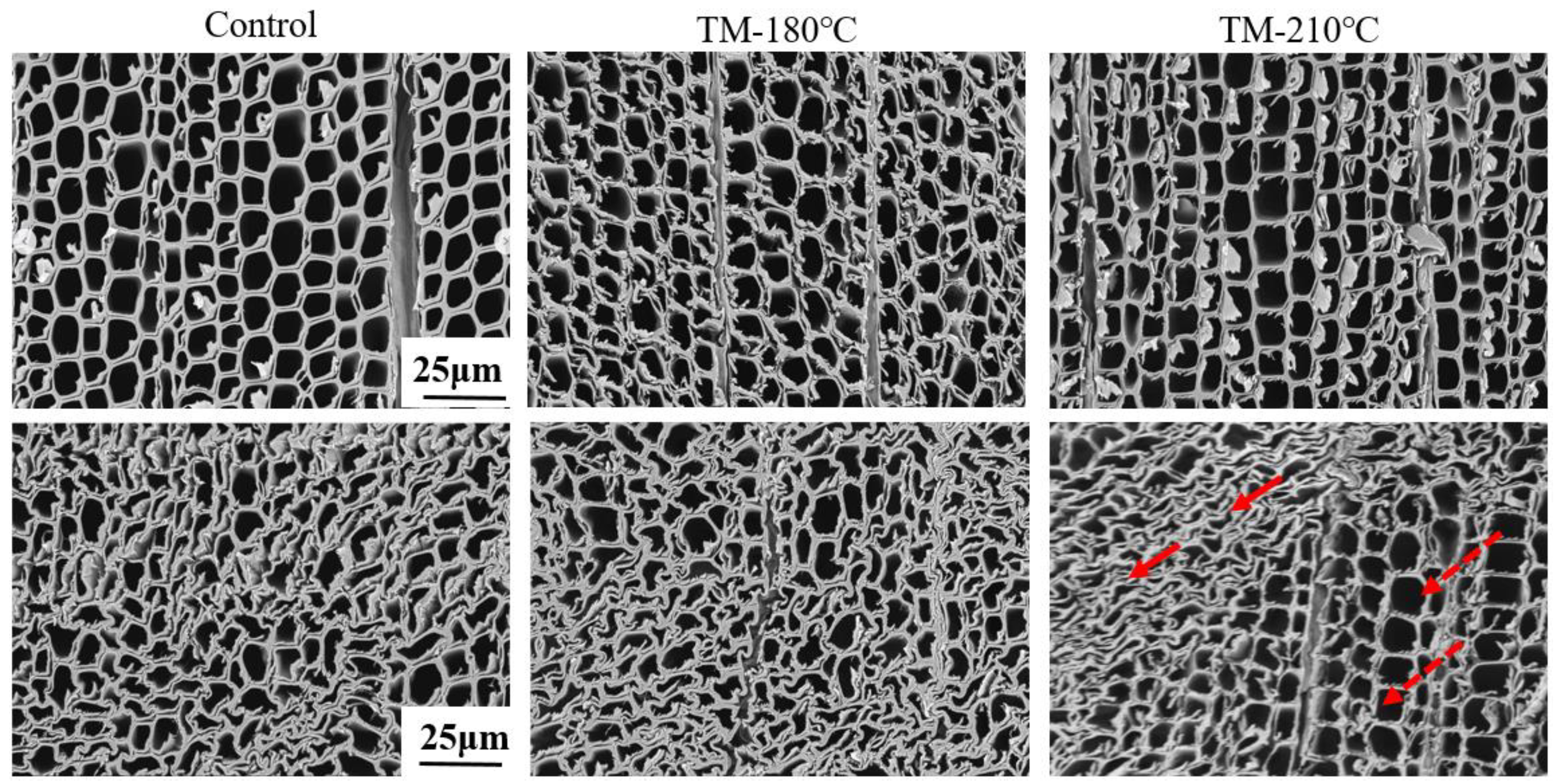

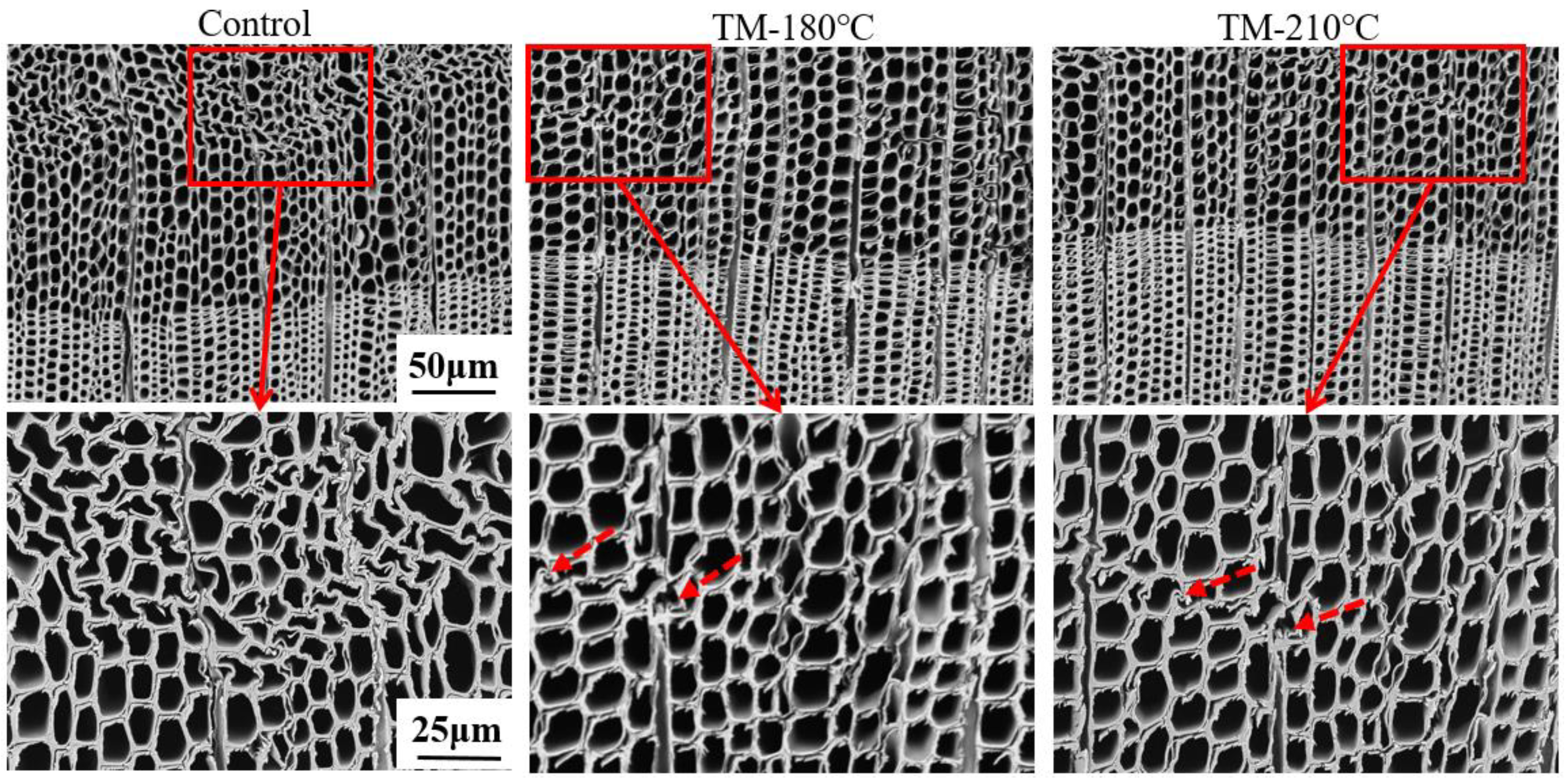
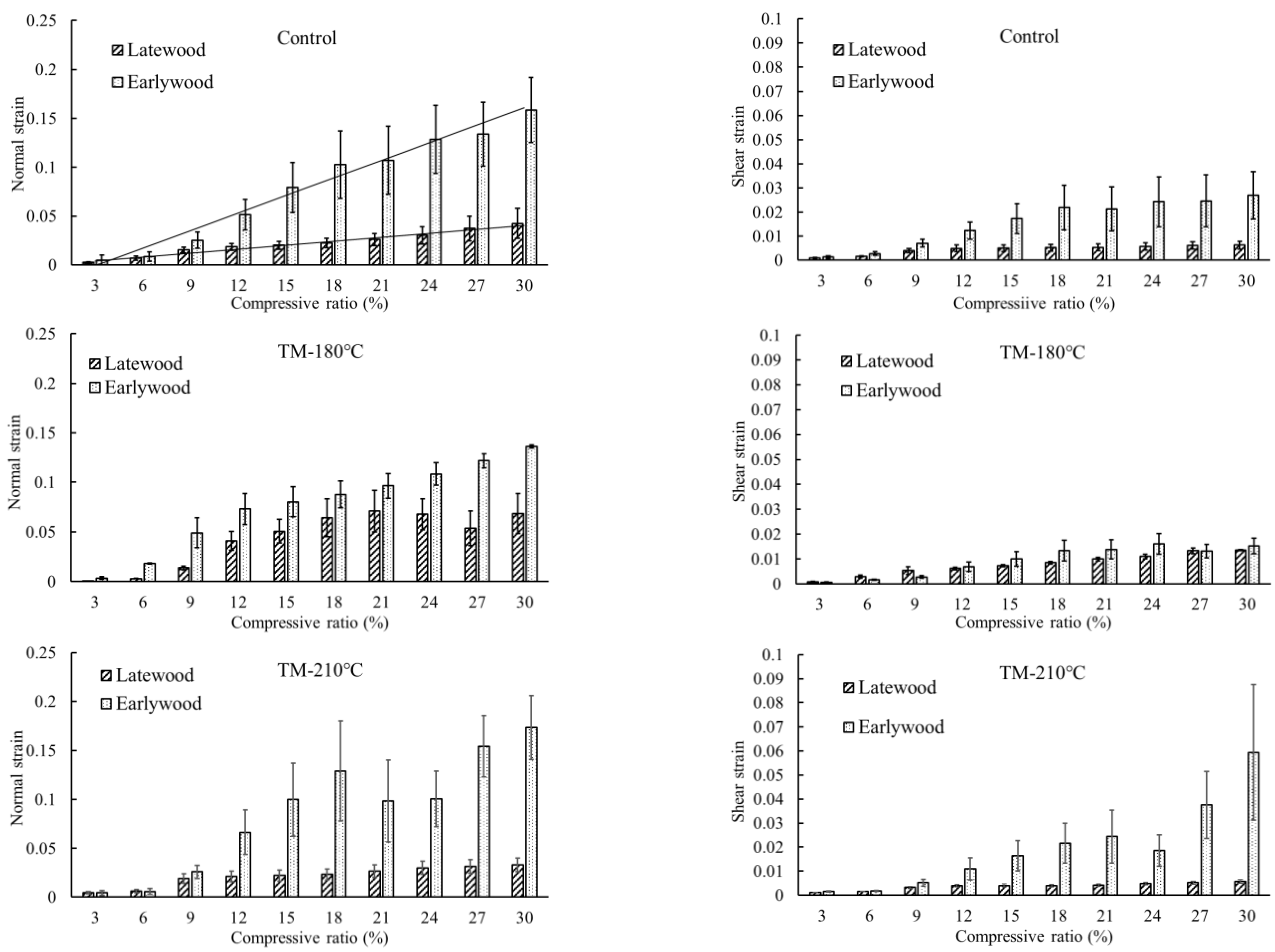

| Sample (N = 5) | Control | TM-180 °C | TM-210 °C |
|---|---|---|---|
| EW (%) | 58.6 (18.9) | 29.0 (7.9) | 10.8 (3.8) |
| LW (%) | 49.1 (36.2) | 35.3 (24.8) | 23.9 (14.9) |
| ELW (%) | 61.1 (4.4) | 33.9 (11.7) | 16.2 (6.1) |
| ELW-E (%) | 80.0 (14.9) | 44.4 (16.0) | 21.6 (9.6) |
Disclaimer/Publisher’s Note: The statements, opinions and data contained in all publications are solely those of the individual author(s) and contributor(s) and not of MDPI and/or the editor(s). MDPI and/or the editor(s) disclaim responsibility for any injury to people or property resulting from any ideas, methods, instructions or products referred to in the content. |
© 2023 by the authors. Licensee MDPI, Basel, Switzerland. This article is an open access article distributed under the terms and conditions of the Creative Commons Attribution (CC BY) license (https://creativecommons.org/licenses/by/4.0/).
Share and Cite
Wang, J.; Yang, K.; Li, W.; Wang, X.; Van den Bulcke, J.; Van Acker, J. The Impact of Earlywood and Latewood on the Compressive Stress of Thermally Modified Douglas Fir. Forests 2023, 14, 1376. https://doi.org/10.3390/f14071376
Wang J, Yang K, Li W, Wang X, Van den Bulcke J, Van Acker J. The Impact of Earlywood and Latewood on the Compressive Stress of Thermally Modified Douglas Fir. Forests. 2023; 14(7):1376. https://doi.org/10.3390/f14071376
Chicago/Turabian StyleWang, Junfeng, Kai Yang, Wanzhao Li, Xinzhou Wang, Jan Van den Bulcke, and Joris Van Acker. 2023. "The Impact of Earlywood and Latewood on the Compressive Stress of Thermally Modified Douglas Fir" Forests 14, no. 7: 1376. https://doi.org/10.3390/f14071376
APA StyleWang, J., Yang, K., Li, W., Wang, X., Van den Bulcke, J., & Van Acker, J. (2023). The Impact of Earlywood and Latewood on the Compressive Stress of Thermally Modified Douglas Fir. Forests, 14(7), 1376. https://doi.org/10.3390/f14071376









